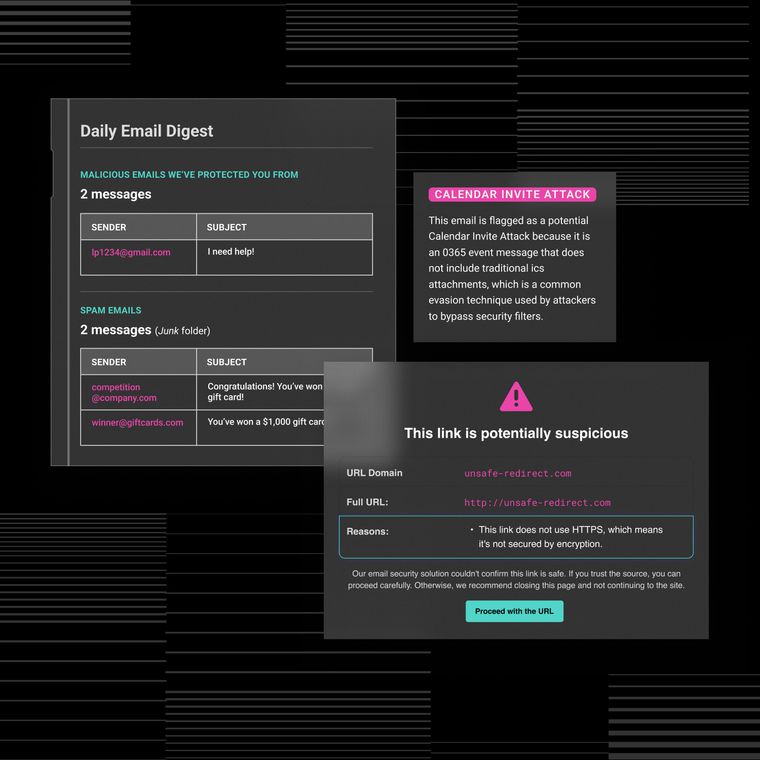How to Strengthen Risk Awareness Across Your Organization
Empower teams to make better decisions with realistic risk training and communication tactics.
July 29, 2025
Verizon’s 2025 Data Breach Investigations Report reveals that ransomware now figures in 44 percent of all breaches. Behind each attack is a threat actor counting on just one employee clicking a malicious link.
The solution isn't better technology but rather, it's transforming your workforce from vulnerability to strength through risk-aware culture. Organizations that embed security awareness across every department experience fewer incidents, lower costs, and better decision-making. Compliance becomes natural when employees understand how daily actions impact security.
Building this culture requires more than security team initiatives. The following seven strategies that follow will embed risk awareness organization-wide, transforming security from a checklist into shared discipline that protects operations and enables growth.
1. Lead by Example: Executive Engagement in Risk Conversations
Leaders who visibly own risk conversations determine whether a risk-aware culture sticks or stalls. Executives must actively participate in workshops and committee meetings to demonstrate that managing uncertainty is core business, not a side project.
Here are the steps to take:
Model Engaged Participation
When leaders sit in the room, ask probing questions, and share personal lessons, they signal urgency and accountability. Invite executives to tabletop exercises that dramatize financial stakes, providing concise briefs beforehand so they can contribute informed opinions rather than delegating.
Establish a Routine and Public Discussions
Set standing risk agenda items in executive meetings to normalize the topic and ensure it remains a priority. The Risk Leadership Network reports that boards that discuss risk quarterly experience faster incident escalation. Leaders should recap key takeaways in town halls and newsletters, reinforcing transparency and inviting feedback.
Embed Assessment in Strategic Choices
Integrate risk assessment into every major initiative, including acquisitions, product launches, and budget shifts. Frame decisions with risk-adjusted metrics to move from gut instinct to data-driven judgment. When the CFO sees how a phishing breach could delay market entry, funding for email security becomes a prerequisite for growth.
Executive engagement transforms risk awareness from a compliance checkbox to a business practice, setting the stage for organization-wide communication.
2. Tailor Risk Communication to Different Audiences
One-size-fits-all messaging dilutes urgency; audience-specific language ensures every team grasps why risk matters and what to do next. Targeted communication ensures every department speaks the same risk language in their own dialect, building on the executive foundation.
Begin with discovery through short surveys revealing each group's priorities and preferred channels. Operations teams need direct, action-oriented instructions during shift changes. Finance departments seek analytical depth, with dollar-value scenarios illustrating how weak controls affect revenue. IT teams prefer concise updates through ticketing systems, while leadership requires strategic briefings that map threats to business objectives.
Keep language plain such as - "critical patch delay" beats "CVSS 9.8 remote-code execution." Reinforce messages through multiple channels to drive retention. By meeting each audience on its terms, you bridge the security-business gap and transform passive listeners into active risk owners.
Tailored communication creates receptivity for deeper learning, especially when reinforced through systematic training programs.
3. Incorporate Risk Awareness into Onboarding and Training
Embed risk education on day one and reinforce regularly to develop security-first reflexes that scale with growth. Integrate training into the employee journey from the first day forward rather than treating it as an annual event.
Here are the steps you need to take:
Begin onboarding with concise modules that explain how mishandling a single malicious link can lead to financial loss.
Use interactive formats, such as simulations, quizzes, and scenario videos to improve engagement and retention.
Tailor content by role. For instance, let developers practice secure code reviews, finance teams study fraud red flags, and and executives review compliance mandates.
Schedule quarterly refreshers that surface emerging threats through microlearning bursts.
Deploy phishing simulations throughout the year to educate and measure progress: falling click rates and rising report rates indicate program success.
Pair newcomers with mentors who model secure behavior and answer "what to do after a phishing attack" in real time.
Continuous training transforms risk awareness from a compliance checkbox into a sustained engine for organizational risk literacy, especially when reinforced with real-world examples.
4. Use Real-Life Scenarios and Case Studies
Real-life incidents embed risk concepts more deeply than abstract policies by illustrating concrete stakes and consequences. This is because when employees experience a genuine security breach scenario, they remember the lesson.
Start with anonymized internal events such as near misses, suspicious emails, and policy violations, to create immediacy. Layer in industry examples if needed and also highlight who made which decision, what alternatives existed, and how outcomes could have changed.
Structure scenarios using a three-act framework: setup, decision point, consequence. Alternate failures with successes; praising the team that spotted a suspicious link reinforces desired behavior as effectively as showing the consequences of clicking on malicious links. Insert interactive pauses where participants choose responses before revealing outcomes.
Map every scenario to specific controls so employees see direct relevance to their roles. Close with transfer discussions about how examples mirror threats in daily workflows.
Real-world scenarios build critical thinking and problem-solving, making security everyone's responsibility, but only if employees can navigate policies during actual incidents.
5. Create Simple, Clear Policies and Guidelines
Complexity buries risk controls; streamlined, plain-language policies keep every employee aligned and accountable. Remember, dense rulebooks force people to improvise, introducing silent risk. Organizations with simplified approaches report faster decision cycles and fewer compliance gaps.
These are some steps you can take:
Start by eliminating duplicates, map every policy to a single owner, delete overlaps, and retire outdated clauses.
Replace jargon with verbs and short sentences, then pilot with frontline staff to confirm clarity.
Convert multi-step approvals into one-page flowcharts highlighting "stop" and "go" points.
Centralize access in an indexed knowledge base where quick searches surface exact controls.
Implement quarterly reviews and anonymous feedback loops to ensure guidelines evolve in tandem with the business, without creating bureaucratic drift.
Teams following these simplification strategies report higher adoption because employees can act without second-guessing, resulting in measurable risk reduction, less shadow IT, fewer exceptions, and stronger audit outcomes.
Clear policies create the foundation for safe reporting, but effectiveness depends on employees trusting the feedback process.
6. Establish Feedback Loops and Encourage Reporting
Open, protected feedback loops turn every employee into an early-warning system that surfaces threats before they escalate. When reporting is easy and safe, you multiply your security team's reach without adding headcount.
Implement anonymous reporting tools with encryption and third-party hosting to ensure confidentiality. Complement this with a neutral ethics hotline staffed outside your reporting chain, thereby removing the perception of bias and signaling leadership's commitment to transparency.
Hold quarterly feedback sessions to review what was reported, how it was handled, and what changes were made. Closing the loop shows that speaking up triggers action, not bureaucracy. Codify anti-retaliation language in policies so employees know their careers won't suffer for responsible reporting. Acknowledge submissions within 24 hours and provide regular resolution updates.
Celebrate useful reports in town halls and recognition programs to reinforce desired behavior. The result: a "human sensor network" that complements automated monitoring and catches emerging threats while still inexpensive to fix.
These feedback mechanisms generate valuable data, but only systematic measurement reveals program effectiveness.
7. Measure Awareness and Adjust Strategies Continuously
Data-driven measurement forms the backbone of effective risk awareness; you cannot improve what you don't measure. The following are the steps you need to take:
Track Key Performance Indicators
Capture baseline metrics across three areas: training completion rates, simulation click rates, and incident escalation times. Monitor weekly as you implement initiatives, falling click rates and faster reporting confirm knowledge converts to behavior.
Translate Data Into Executive Action
Create dashboards tracking threats identified, mitigated, and closed over time. Pair quantitative metrics with culture indicators to demonstrate bottom-line impact. Present monthly summaries connecting awareness investments to reduced security incidents and compliance violations.
Execute Continuous Improvement Cycles
Follow a closed-loop process: measure, act, re-measure, refine. Progress from basic compliance metrics to behavioral indicators that reveal organizational change. When leaders see evidence that awareness reduces incidents, funding questions disappear.
Remember continuous measurement transforms risk awareness from discretionary expense to strategic advantage.
Sustained Risk Awareness Builds Organizational Resilience
Risk awareness demands continuous attention, not one-time initiatives. These seven strategies create a reinforcing system that reduces incidents, sharpens decision-making, and strengthens compliance.
Remember, organizations that invest in a risk-aware culture consistently document improved outcomes, transforming risk from afterthought to operational advantage. Get started with strategies aligned to your current priorities, perhaps refining onboarding or launching reporting channels, then expand systematically. The result is a workforce that treats risk as part of daily operations, not just exception handling.
Ready to strengthen your organization's security posture? Book a demo with Abnormal to discover how our AI-driven platform combines advanced email security with managed awareness training, helping you build the risk-aware culture that protects your business while reducing the burden on your team.
Related Posts
Get the Latest Email Security Insights
Subscribe to our newsletter to receive updates on the latest attacks and new trends in the email threat landscape.


